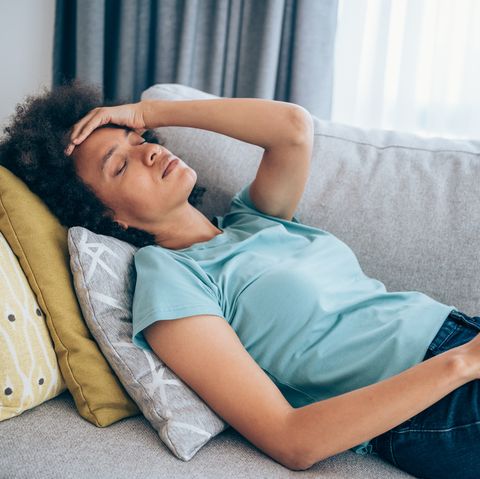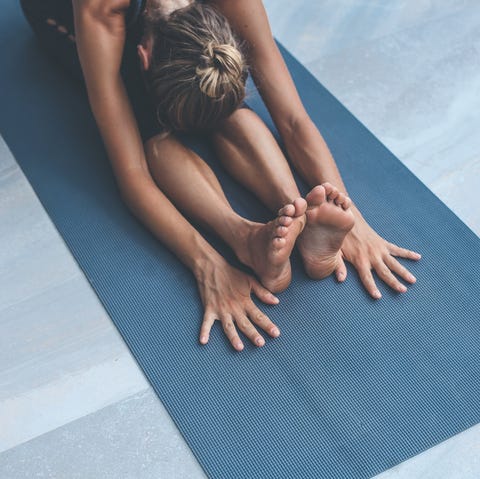If you’re part of the estimated 12% of the population that gets migraines, you know they can be debilitating. When you’re in the midst of an attack and suffering from migraine symptoms like aura, throbbing pain, nausea, fatigue and sensitivity to light and/or sound, you’ll do nearly anything for relief. While seeing a neurologist for a doctor-approved treatment plan is the most effective thing you can do, there are some home remedies for migraines that can relieve some of your discomfort in the meantime. Consider the research-backed approaches listed below.
Natural home remedies for migraines
1.Find a dark, quiet space.
Many people with migraines have light or sound sensitivity so resting in a dark, quiet room can make a big difference, according to Lauren Natbony, M.D., the medical director of Integrative Headache Medicine of New York and an assistant clinical professor of neurology at the Icahn School of Medicine at Mount Siniai.
2. Try relaxation techniques.
“When someone’s in pain, there tends to be a big fight or flight response in the body,” says Simy Parikh, M.D., an assistant professor of neurology at the Jefferson Headache Center at Thomas Jefferson University. “That type of thing will speed up someone’s breathing or make the breathing very shallow. It can make someone’s heart race, and it can make muscles tense up. So understanding that and then realizing that things like relaxation techniques or breathing techniques can be very useful to reduce that fight or flight response can be something that will actually end up reducing your own perception of the pain.”
There are different techniques that work for each of us, so Dr. Parikh recommends finding a psychologist who will use biofeedback to measure your breathing rate and heart rate as you try different approaches to see which has the best effects. “Those are tools that you can use at home,” says Dr. Parikh.
3. Make sure you have ice.
A regular ice pack will help, but Dr. Natbony says you can also buy an “ice hat” that you keep in the freezer until a migraine hits. “A lot of patients find them really, really helpful to put on in the midst of a migraine attack,” says Dr. Natbony. That way, you don’t have to sit in an awkward position trying to keep the ice on your head. It’s also designed to cover your eyes if that offers some relief.
4. Change up your light.
“Exposing yourself to pure green light during a migraine attack can help get rid of the pain as well as the light sensitivity,” says Dr. Natbony. “I think that’s a tool that is not used enough, and there are actually studies on it.” She recommends buying a green light bulb — like Norb Relief — and placing it in a lamp near a comfortable spot where you can lay down and relax when you have a migraine.
5. If you can, go to sleep.
“Sleep is probably one of the best things,” says Dr. Natbony. “It tends to reset the body.” It’s not always possible, but if you have the luxury to sleep during a migraine, go for it. (High-quality, consistent sleep may also help prevent migraines.)
6. Perform acupressure.
Unlike acupuncture, acupressure can be performed on your own during a migraine episode. Research shows that pressing on specific acupressure sites may help relieve the nausea or fatigue that stems from migraines. Putting pressure on other points may reduce pain.
7. Take magnesium.
Research shows that magnesium can help prevent migraines and lessen the severity of migraines that have started. “For treatment, it’s usually a bit of a higher dose than you would use for prevention,” says Dr. Natbony. Of course, ask your doctor what they recommend before you take any supplement. Eating foods that are rich in nutrients like magnesium may help with migraines, too.
8. Invest in aromatherapy.
Lavender and peppermint oils can be helpful in providing pain relief, according to research. Studies are limited, says Dr. Natbony, but it really can’t hurt to see if they work for you. She recommends buying essential oil sticks that you can roll on your temples or wrist during a migraine. Just remember to never apply undiluted essential oil to your skin — it can cause a very bad reaction.
9. Or Tiger Balm.
Some research has found that rubbing a bit of Tiger Balm, an ointment usually used for muscle aches, on your temples can help relieve tension headaches. While migraines aren’t the same as tension headaches, Dr. Natbony says some migraine patients find Tiger Balm to be effective, and it can’t hurt to try.
10. Drink some coffee.
“Caffeine is a double-edged sword,” says Dr. Natbony. “If you have low-frequency migraines, absolutely, caffeine can work and combining caffeine with medication like Tylenol, Advil or Aleve can make it work better.” However, she says, sometimes caffeine can help at the moment and cause rebound pain later on.
11. Do yoga.
For some people, moving when you have a migraine can make it worse. That said, research shows that sometimes gentle stretching like tai chi or yoga can help. “These things emphasize paying attention to breathing patterns and muscle tension can be helpful to give you feedback into what your body’s doing,” says Dr. Parikh.
12. Take ginger
Yes, migraines hurt, but they can cause a lot of additional symptoms on top of the pain—such as nausea. That’s where research-backed ginger comes in. “There are over-the-counter things you can use for nausea, but I think that nausea does help to treat upset stomach,” says Dr. Natbony. “Having a ginger lozenge or drinking ginger tea can definitely be helpful.”
13. When it doubt, take OTC meds.
“Home remedies” don’t have to be natural — you just have to be able to put them into use at home. Over-the-counter pain relievers like ibuprofen, naproxen or acetaminophen can be extremely helpful in making you more comfortable until you can make an appointment with your doctor, even if they’re not as powerful as prescription medications. Dr. Natbony recommends taking one as soon as the migraine hits for it to be the most effective. “Take the highest recommended dosage that’s appropriate, obviously consulting with your doctor,” she says. Keep in mind some pain medications can have negative side effects if you take them long-term, so if you’re having frequent migraines, it’s best to have a physician tailor your treatment.
The bottom line:
“If a migraine is disabling enough that a person finds themselves needing something at home to treat themselves often, especially with over-the-counter medications, that’s a signal to me that they should talk to their doctor about it,” says Dr. Parikh. “There are really great medicines specifically for migraine that can help them just completely take away the headache attack and hopefully reduce the risk of it becoming more of a chronic migraine.” Your doctor can set you up with a migraine prevention plan as well as help you write down an in-the-moment treatment plan. That way, you’ll know exactly what to do when a migraine starts — what medicines to take, where to go sit or lay down in your home, what breathing techniques to employ, what to drink. In the moment, it can be hard to focus and think about what to do, but Dr. Parikh says having a plan will help calm the anxiety that can exacerbate a migraine.
This content is created and maintained by a third party, and imported onto this page to help users provide their email addresses. You may be able to find more information about this and similar content at piano.io


